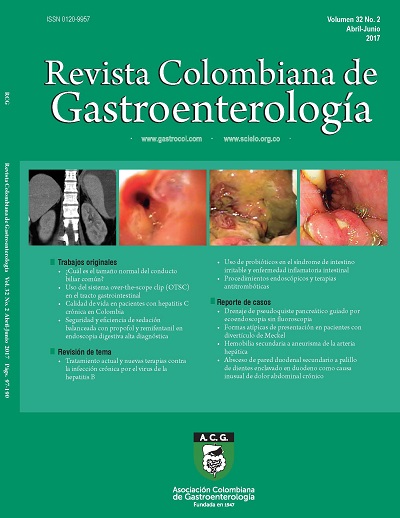Seguridad y eficiencia de sedación balanceada con propofol y remifentanil en endoscopia digestiva alta diagnóstica. Una experiencia exitosa
DOI:
https://doi.org/10.22516/25007440.140Palabras clave:
Sedación, endoscopia digestiva alta diagnóstica, propofol, remifentanil, sedación balanceadaResumen
La sedación es una técnica anestésica de amplia utilización en los procedimientos endoscópicos digestivos actuales dado su claro beneficio en la tolerancia y comodidad para el paciente y el endoscopista. El medicamento de mayor uso en la actualidad para utilizarse como monosedación es el Propofol, pero los esquemas balanceados utilizando más de un medicamento ahora son ampliamente usados en endoscopia diagnóstica o terapéutica. La sedación balanceada utilizando Propofol y Remifentanil permite la potenciación sinérgica de un sedante con un opioide de ultra corta acción, lo que a su vez favorece la disminución respectiva de cada dosis. Se presenta una serie de 1148 pacientes llevados a endoscopia digestiva alta diagnóstica con dosis promedio de Remifentanil de 0,9 mcg/kg de peso, y de Propofol de 0,47mg/kg de peso, sin eventos adversos graves, con excelente satisfacción para el endoscopista y con muy bajo costo de la dosis por medicamento, con lo que se infiere ser un esquema seguro y eficiente.
Descargas
Lenguajes:
esReferencias bibliográficas
Knape JT, Adriaensen H, van Aken H, Blunnie WP, Carlsson C, Dupont M, et al. Guidelines for sedation and/or analgesia by non-anaesthesiology doctors. Eur J Anaesthesiol. 2007; 24: pp 563-7. doi: https://doi.org/10.1017/S0265021506002092
Cohen LB, Delegge MH, Aisenberg J, Brill JV, Inadomi JM, Kochman ML, et al. AGA Institute rewiew of endoscopic sedation. Gastroenterology 2007; 133: 675-701 doi: https://doi.org/10.1053/j.gastro.2007.06.002
American Society of Anesthesiologists Task Force on Sedation and Analgesia by Non-Anesthesiologists. Practice guidelines for sedation and analgesia by non-anesthesiologists. Anesthesiology. 2002; 96: 1004-17. doi: https://doi.org/10.1097/00000542-200204000-00031
Lightdale JR. Preparación y sedación del paciente para endoscopia. En: Classen M, Tytgat G N.J, Lightdale CJ, et al editores. Endoscopia gastroenterologica. Tomo 1. 2a ed. Venezuela: Amolca; 2012. p. 57 – 65
Mao W, Wei XQ, Tao J, Zhen FP, Wen ZF, Wu B, et al. The safety of combined sedation whit Propofol plus fentanyl for endoscopy screening and endoscopic variceal ligation in cirrhotic patients. Journal of Digestive Diseases. 2014; 15: 124-130. doi: https://doi.org/10.1111/1751-2980.12115
Jamieson J. Anesthesia and sedation in the endoscopy suite? (Influences and opinions). Curr Opin Anesthesiol. 1999; 12: 417-23. doi: https://doi.org/10.1097/00001503-199908000-00004
Lee KC, Lee S-H, Chung I-H, Lee TH, Park S-H, et al. Balanced Propofol sedation for therapeutic GI endoscopic procedures: a prospective, randomized study. Gastrointestinal endoscopy. 2011; 73 (2): 206-14. doi: https://doi.org/10.1016/j.gie.2010.09.035
Cohen LB, Hightower CD, Wood DA, Miller KM, Aisenberg J. Moderate level sedation during endoscopy: a prospective study using low-dose Propofol, meperidine/fentanyl, and midazolam. Gastrointest Endosc 2004; 59: 795-803. doi: https://doi.org/10.1016/S0016-5107(04)00349-9. doi: https://doi.org/10.1016/S0016-5107(04)00628-5
Keats AS. The ASA classification of physical status – a recapitulation. Anesthesiology 1978; 49: 233-6. doi: https://doi.org/10.1097/00000542-197810000-00001
Yao K. The endoscopic diagnosis of early gastric cáncer. Ann Gastroenterol 2013; 26 (1): 11-22.
Lee JY, Kim N. Diagnosis of Helicobacter pylori by invasive test: histology. Ann Transl Med. 2015; 3 (1): 10.
Sachdeva A, Bhalla A, Sood A, Duseja A, Gupta V, et al. The effect of sedation during upper gastrointestinal endoscopy. Saudi J Gastroenterol. 2010; 16: 280-4. doi: https://doi.org/10.4103/1319-3767.70616
Kenneth R, Laine L. A systematic review and meta-analysis of randomized, controlled trials of moderate sedation for routine endoscopic procedures. Gastrointest Endosc. 2008; 67: 910-23. doi: https://doi.org/10.1016/j.gie.2007.12.046
Abraham NS, Fallone CA, Mayrand S, Huang J, Wieczorek P, Barkun AN. Sedation versus no sedation in the performance of diagnostic upper gastrointestinal endoscopy: a Canadian randomized controlled cost-outcome study. Am J Gastroenterol. 2004; 99: 1692-9. doi: https://doi.org/10.1111/j.1572-0241.2004.40157.x
DeLegge MH. When to call the anesthesiologist for assistance whit sedation. Gastrointent Endosc. 2011; 74: 1377-9. doi: https://doi.org/10.1016/j.gie.2011.10.005
American Society of Anesthesiologists. Task Force on Sedation and Analgesia by Non-Anesthesiologists. Practice Guidelines for sedation and Analgesia. An Updated. Anesthesiology. 2002; 96: 1004-17. doi: https://doi.org/10.1097/00000542-200204000-00031
Gonzalez-Huix F, Giné J, Loras C, Martinez E, Dolz C, Gómez C, et al. Documento de posicionamiento de la sociedad catalana de digestología sobre la sedación en endoscopia digestiva. Gastroenterol Hepatol. 2012; 35 (7): 496-511. doi: https://doi.org/10.1016/j.gastrohep.2012.03.009
Faigel DO, Baron TH, Goldstein JL, Hirota WK, Jacobson BC, Johanson JF, et al. Guidelines for the use of deep sedation and anesthesia for GI endoscopy. Gastrointest Endosco. 2002; 52: 613-17.
Chutkan R, Cohen J, Abedi M, Cruz-Correa M, Dominitz J, Gersin K, et al. Training guideline for use of propofol in gastrointestinal endoscopy. Gastrointest Endosc. 2004; 60: 167-72. doi: https://doi.org/10.1016/S0016-5107(04)01699-2
Dumonceau JM, Riphaus A, Aparicio JR, Beilenhoff U, Knape JTA, Ortmann M, et al. and the NAAP Task Force Members: European Society of Gastrointestinal Endoscopy, European Society of Gastroenterology and Endoscopy Nurses and Associates, and the European Society of Anaesthesiology Guideline: Non-anesthesiologist administration of propofol for GI endoscopy. Endoscopy. 2010; 42: 960-74. doi: https://doi.org/10.1055/s-0030-1255728
Cohen LB, Delegge MH, Aisenberg J, Brill JV, Inadomi JM, Kochman ML, Piorkowski Jr JD, AGA Institute review of endoscopic sedation. Gastroenterology. 2007; 133: 675-701. doi: https://doi.org/10.1053/j.gastro.2007.06.002
Cohen APT, Cohen LB, Ladas SD, Vargo JJ, Paspatis GA, Bjorkman DJ, et al. Sedation in digestive endoscopy: the Athens international position statements. Aliment Pharmacol Ther. 2010; 32: 425-42. doi: https://doi.org/10.1111/j.1365-2036.2010.04352.x
Ellet ML. A literature review of the safety and efficacy of using propofol for sedation in endoscopy. Gastroenterol Nurs. 2010; 33: 111-7. doi: https://doi.org/10.1097/SGA.0b013e3181d601fb
Rex DK, Deenadayalu VP, Eid E, Imperiale TF, Walker JA, Sandhu K, et al. Endoscopist-directed administration of propofol: a worldwide safety experience. Gastroenterology. 2009; 137: 1229-37. doi: https://doi.org/10.1053/j.gastro.2009.06.042.
Martinez JF, Aparicio JR, Compa-y L, Ruiz F, Gómez-Escolar L, Mozas I, Casellas JA. Safety of continuous propofol sedation for endoscopic procedures in elderly patients. Rev Esp Enferm Dig. 2011; 103: 76-82. doi: https://doi.org/10.4321/S1130-01082011000200005
García- Suárez C, López-Rosés L, Olivencia P, Lancho A, González-Ramírez A, Santos E, et al. Sedation whit propofol controlled by endoscopists during percutaneous endoscopic gastrostomy. Rev Esp Enferm Dig. 2010; 102: 249-56. doi: https://doi.org/10.4321/S1130-01082010000400005
Heuss LT, Schnieper P, Drewe J, Pflimlin E, Beglinger C. Safety of propofol for conscious sedation during endoscopic procedures in high-risk patients – a prospective, controlled study. Am J Gastroenterol. 2003; 98: 1751-7. doi: https://doi.org/10.1016/S0002-9270(03)00447-7
https://doi.org/10.1111/j.1572-0241.2003.07596.x
Lichtenstein DR, Jagannath S, Baron TH, Andreson MA, Banerjee S, Dominitz JA, et al. Sedation and anesthesia in GI endoscopy. Standards of Practice Committee of the American Society for Gastrointestinal Endoscopy. Gastrointest Endosc. 2008; 68: 815-26. doi: https://doi.org/10.1016/j.gie.2008.09.029
Minsalud.gov.co [Internet]. Bogotá: Ministerio de Salud; 2014 [actualizado 28 may. 2014; citado 03 sep. 2016]. Disponible en: https://www.minsalud.gov.co/Normatividad_Nuevo/Resolución%202003%20de%202014.pdf (33)
Vargo JJ, Cohen LB, Rex DK, Kwo PY, Position statement: nonanesthesiologist administration of propofol for GI endoscopy. Gastrointest Endosc. 2009; 70: 1053 – 1059. doi: https://doi.org/10.1016/j.gie.2009.07.020
Ong WC, Santosh D, Lakhtakia S, Reddy DN. A randomized controlled trial on use of propofol alone versus propofol with midazolam, ketamine and pentazocine "sedate-analgesic cocktail" for sedation during ERCP. Endoscopy. 2007; 39: 807-812. doi: https://doi.org/10.1055/s-2007-966725
Paspatis GA, Manolaraki MM, Vardas E, Theodorepoulou A, Chlouverakis G. Deep sedation for endoscopic retrograde cholangiopancreatography: intravenous propofol alone versus intravenous propofol whit oral midazolam premedication. Endoscopy. 2008; 40: 308 – 313. doi: https://doi.org/10.1055/s-2007-995346
Lee TH, Lee CK, Park S-H, Lee S-H, Chung I-K, Choi HJ, et al. Balanced propofol sedation versus propofol monosedation in therapeutic pancreaticobiliary endoscopic procedures. Dig Dis Sci. 2012; 57: 2113 – 2121. doi: https://doi.org/10.1007/s10620-012-2234-0
Fabbri LP, Nucera M, Marsili M, Al Malyan M, Becchi Ch. Ketamine, propofol and low dose remifentanil versus propofol and remifentanil for ERCP outside the operating room; Is ketamine not only a "rescue drug"? Med Sci Monit. 2012; 18(9): CR575-580. doi: https://doi.org/10.12659/MSM.883354
Trummel J. Sedation for gastrointestinal endoscopy: the changing landscape. Curr Opin Anaesthesiol. 2007; 20: 359-64. doi: https://doi.org/10.1097/ACO.0b013e32827ab467
McQuaid KR, Laine L, A systematic review and meta-analysis of randomized, controlled trials of moderate sedation for routine endoscopic procedures. Gastrointest Endosc, 2008; 67: 910-23.
https://doi.org/10.1016/j.gie.2007.12.046
Vargo JJ, Zuccaro Jr G, Dumot JA, Shermock KM, Morrow JB, Conwell DL, et al. gastroenterologist-administered propofol versus meperidine and midazolam for advanced upper endoscopy: a retrospective, randomized trial. Gastroenterology. 2002; 123: 8 – 16.
https://doi.org/10.1053/gast.2002.34232
Cohen LB, Wecsler JS, Gaetano JN, Benson AA, Miller KM, Durkalski V, et al. Endoscopic sedation in the United States: results from a nationwide survey. Am J Gastroenterol 2006; 101: 967 – 74.
https://doi.org/10.1111/j.1572-0241.2006.00500.x
Anesnet [Internet]. Madrid: Universidad Autónoma de Madrid; 1997 [actualizado 27 mayo 2010; citado 08 sep. 2016]. Disponible en: https://www.uam.es/departamentos/medicina/anesnet/agenda/indice.htm
Mu-oz L, Arévalo JJ, Reyes LE, Balaguera CE, Grupo de Investigación Deorum Opus. Remifentanilo versus propofol con infusión controlada a objetivo en sitio efecto para la sedación de pacientes durante procedimientos endoscópicos gastrointestinales: ensayo clínico controlado aleatorizado. Rev Colomb Anestesiol. 2013; 41 (2): 114-119.
https://doi.org/10.1016/j.rca.2012.11.001
Rosow C. Remifentanil: a unique opioids analgesic. Anaesthesiology. 1993; 78: 875-76
Medina HJ, Galvin EM, Dirckx M et al. Remifentanil as a single drug for extracorporeal shock wave lithotripsy: a comparison of infusion doses in term of analgesic potency and side effects. Anesth Analog. 2005; 101: 365-70.
https://doi.org/10.1213/01.ANE.0000159379.54705.84
Lightdale JR. Preparación y sedación del paciente para endoscopia. En: Classen M, Tytgat G N.J, Lightdale CJ, et al editores. Endoscopia gastroenterologica. Tomo 1. 2a ed. Venezuela: Amolca; 2012. p. 63.
Minto CF, Schnider TW, Short TG, et al. Response surface model for anesthetic drug interactions. Anesthesiology. 2000; 92: 1603 – 16.
https://doi.org/10.1097/00000542-200006000-00017
Duarte NMC, Pires OC, Nunes CEL, et al. Anestesia venosa total. Rio de Janeiro: Sociedade Brasileira de Anestesiologia. 2011; 73 – 82.
Hayes JA, Lopez AV, Pehora CM, et al. Coadministration of propofol and remifentanil for lumbar puncture in children. Anesthesiology. 2008; 109: 613 – 8.
https://doi.org/10.1097/ALN.0b013e31818629f3
Uliana GN, Milla Tambara E, Pedroso Baretta GA. Use of remifentanil to reduce propofol injection pain and the required propofol dose in upper digestive tract endoscopy diagnostic tests. Rev Bras Anestesiol. 2015; 65(6): 437 – 444.
https://doi.org/10.1016/j.bjan.2015.08.002
Egan TD, Kern SE, Muir KT, et al. Remifentanil by bolus injection: a safety, pharmacokinetic, and age effect investigation in human volunteers. Br J Anaesth. 2004; 92: 335 – 43.
https://doi.org/10.1093/bja/aeh075
Fidler M, Kern SE. Flexible interaction model for complex interactions of multiple anesthetics. Anesthesiology. 2006; 105: 286 – 96.
https://doi.org/10.1097/00000542-200608000-00011
Jeong CW, Lee SH, Ju J, et al. The effect of priming injection of different doses of remifentanil on injection pain of microemulsion propofol premixed with lidocaine. Korean J Anesthesiol. 2011; 60: 78 – 82.
https://doi.org/10.4097/kjae.2011.60.2.78
Lee JR, Jung CW, Lee YW. Reduction of pain during induction with target – controlled propofol and remifentanil. Br J Anaesth. 2007; 99: 876 – 80.
https://doi.org/10.1093/bja/aem293
Lee JY, Yang HJ, Choi SH, et al. The optimal effect – site concentration of remifentanil to attenuate the pain caused by propofol. Korean J Anesthesiol. 2012; 63: 108 – 12.
Descargas
Publicado
Cómo citar
Número
Sección
Licencia
Aquellos autores/as que tengan publicaciones con esta revista, aceptan los términos siguientes:
Los autores/as ceden sus derechos de autor y garantizarán a la revista el derecho de primera publicación de su obra, el cuál estará simultáneamente sujeto a la Licencia de reconocimiento de Creative Commons que permite a terceros compartir la obra siempre que se indique su autor y su primera publicación en esta revista.
Los contenidos están protegidos bajo una licencia de Creative Commons Reconocimiento-NoComercial-SinObraDerivada 4.0 Internacional.

| Estadísticas de artículo | |
|---|---|
| Vistas de resúmenes | |
| Vistas de PDF | |
| Descargas de PDF | |
| Vistas de HTML | |
| Otras vistas | |
















